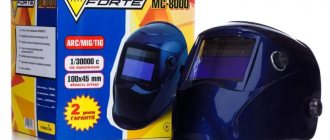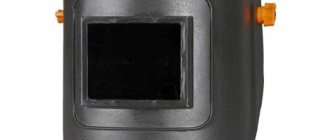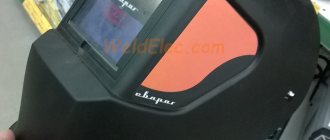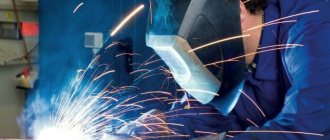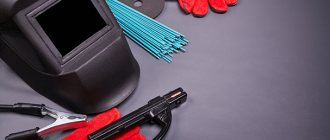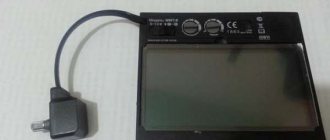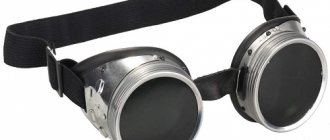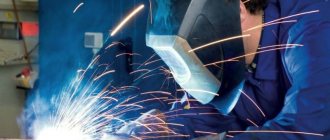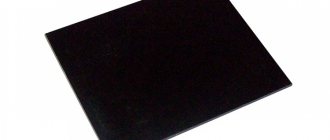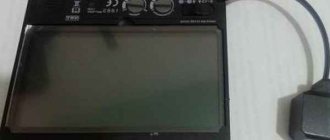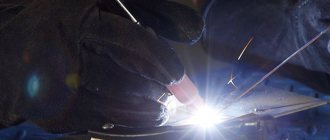Chameleon type welding helmets are so named because the light filter automatically changes the degree of darkness depending on the intensity of the light flux. This is much more convenient than a regular shield or an old type mask with a replaceable filter. Having put on the chameleon, you can clearly see everything even before you start welding: the filter is almost transparent and does not interfere with your work. When the arc is ignited, it darkens in a matter of seconds, protecting your eyes from burns. After the arc goes out, it becomes transparent again. You can carry out all the necessary manipulations without removing the mask, which is much more convenient than raising and lowering the protective shield and much better than holding the shield in your hand. But a wide selection of different priced items can be confusing: what is the difference, and which one is better? We'll tell you how to choose a chameleon mask below.
Chameleon welding masks come in a wide variety. Choosing is not an easy task at all. Moreover, it is not so much the appearance that is important, but the quality indicators
Types of glass
A light filter for a welding helmet protects human eyes from thermal, infrared, ultraviolet radiation and splashes of molten metal.
When welding, cheap filters with a fixed degree of darkness (colored glass), expensive automatic filters for a welding mask (popularly called a chameleon) and polymer materials are used.
Tinted glass. To reduce light transmittance, impurities of non-ferrous metals (copper and nickel) are added to the material. Its light transmittance depends on the content of impurities in glass.
There are Russian and international markings for the degree of darkness. The domestic classification is marked from C4 to C8, which corresponds to the European 9-13 DIN. The table (below) will help you understand the correspondence of markings.
Glass Chameleon. Automatic windows use a liquid crystal screen. Liquid crystals change the construction sequence when the light voltage changes, thereby achieving different darkening. Modern filters have from 1 to 3 layers of LCD glass.
Polymer materials. They have high ductility and darkening ability.
Welding masks use combined materials, polymer film for protection against mechanical damage, and glass. Which, if necessary, are easily replaced.
Video:
Differences in glass darkness
The domestic industry supplies the market with light filters for welding marked C4-C8, corresponding to the European classification 9-13 DIN. Light-tinted glass C4 and C8 have no external differences. But C4 has less protection.
When choosing (purchasing), you can check the filter for counterfeit using a fluorescent lamp. Through glass C4 the filament of the light bulb will be clearly visible, but through glass C8 it will be difficult to see. If there are no differences, then it is better to refuse the purchase.
Pros advise having 2-3 filters with different protection for a welder’s mask. Then during welding work you can choose the best option.
The table (below) will help you select the degree of darkening of welding filters depending on the welding current and type of welding.
The table shows the recommended values. Depending on the weld, you can choose a shade that is one number less or more.
Sometimes, glass for electric welding marked E.1-E.5 comes on sale.
Chameleon light filter for welding helmet
Automatic liquid crystal filters have advantages over their fixed counterparts. Extensive settings adjust the dimming to any brightness and arc diameter.
Chameleon has several layers of crystals located in layers of polymer protection, a power supply and control unit, and arc detection sensors.
An automatic light filter is not a complicated device:
- the device is attached to the mask with two screws;
- Powered by a solar panel and replaceable batteries;
- has 3 control devices:
- Shade control 5-13 DIN and 9-13 DIN. The location is external (on the left side of the mask) or internal (on the filter itself).
- sensitivity (moment of automatic dimming) is adjusted depending on the time of day (day, night).
- dimming time adjustment (long, medium and short).
Video:
Rules for using filters
To ensure that a welder wearing a mask is not only comfortable, but also safe, the following rules are adhered to when performing work:
- Before you start welding, you must check the functionality of the light filter using a lighter. If it gets dark, then everything is fine, in other cases the malfunction is due to damage to the glass or a breakdown of the power supply.
- You cannot use chameleon filters if they do not have an outer or inner layer.
- If there are scratches or cracks on the glass surface, use of the product is prohibited. This is dangerous for your eyesight.
- To clean filters for welding helmets from dirt, use only a soft cloth. This should not be done with abrasives or sharp objects.
We recommend reading: How to install a hood above a welding table
Before welding, you need to check the functionality of the light filter.
Rules for choosing filters
Before purchasing masks or glasses, you should understand the optical characteristics of light filters and the specifics of using the products.
Recommendations for choosing filters for welding
- If you regularly carry out welding work, you should choose the “Chameleon” mask.
- The size of the filter determines visibility and comfort during welding activities.
- The filter response time can vary from 0.03 to 0.0001 s.
- You should choose models with continuously adjustable dimming levels, which are more comfortable than stepped ones.
- It is recommended to use universal filters that have a shade of 9-13 DIN.
- The optical class of the filter determines the clarity and visibility of the image through glass (the best option has an indicator of 1).
Additional features
Additionally, it is necessary to pay attention to: dispersion, homogeneity and angular dependence of light filters, what type of welding will be used, current indicators, the risk of mechanical effects.
When choosing protective devices, it is important to decide how the work will be carried out: indoors or outdoors.
The type of work carried out is indicated by markings: E – electric welding, G – gas welding,
B – auxiliary work, C – marking for “Chameleon” type filters.
Marking of different types of welding
To ensure uninterrupted operation of the filter, you should pay attention to:
- an adjustment unit, which can be accessed on the front side of the mask, which allows for correction without stopping work;
- on/off system that increases the longevity of the power supply and filter;
- availability of changing power sources;
- the number of sensors that determine the response time;
- possibility of adjusting parameters.
When choosing a model, it is recommended to choose filters marked 1/1/1/2, which determines the relationship to the optical class, uniformity and light dispersion.
When purchasing, it is important to study the product certificate, warranty period, and location of service centers.
Explanation of the symbols on the welding mask
Criteria for selecting welding filters
To choose a product yourself, take into account the following characteristics:
- Appearance. There must be no damage. The documentation must include information about the optical class of filters and the manufacturer. If this data is not available, and you only learn the characteristics from the seller’s words, then it is better to refuse to purchase such a mask.
- Number of settings, their varieties. High-quality chameleon glass has 3 adjustable parameters: dimming level, light sensitivity level and shutdown delay time.
- Dimensions. In different models of masks, the size of the glass seat may vary, but most often it is 110x90 or 120x70 mm. This is taken into account when purchasing a replacement filter, otherwise you will not be able to insert it into its place.
- Glass type. Its dimming can be constant or change with fluctuations in the intensity of the luminous flux. If the same welding work is carried out, then a permanent darkening filter is used, because it is cheap, but can still protect the welder’s eyes. When working with frequently changing current strength, it is better to purchase a chameleon.
- Additional protection. A polymer film is glued to the glass, which protects it from mechanical damage resulting from impacts from various solid particles and objects.
We recommend reading: How to choose a gasoline welding generator
To choose a light filter yourself, you need to consider the type of glass.
GOST regulating the characteristics of light filters
There is a special GOST 12.4.035-78 that regulates the requirements for welding helmets. Although it was developed more than 40 years ago, during this time the necessary changes were made to it, so it is still in effect today. Here we describe the basic technical requirements for welding helmets, goggles, shields, the light filters used in them and other important nuances.
There is a GOST with requirements for light filters.
List of markings
When indicating technical characteristics, the following designations are applied to the mask:
- The degree of shading is the main indicator indicating for what work the specified protective glass is suitable. In Russia, this parameter is marked with the letter C, and abroad – DIN. The higher the number, the lower the glass throughput and vice versa.
- Level of light dispersion. It characterizes the speed of the filter’s response to changes in the light flux, which increases with increasing welding current. This indicator is taken into account only for models with auto-darkening filters. There are 3 degrees, if the number 1 is indicated, then the protection works quickly, the image clarity is high.
- Uniformity of shading. In the production of colored glass, compounds of different metals are used. If the technology has been violated, they are poorly homogenized, so the material turns out to be heterogeneous, as a result, some areas of the filter will be darkened more, others less. The guarantee of high quality is 1st class.
- Optical view of glass. This indicator is influenced by the materials used for its manufacture. If the number 1 is indicated, then this filter provides darkness regardless of the angle at which the light beam hits it. The welder needs to think about the production process, and not about how to correctly turn his head in relation to the work site.
For high-quality eye protection, choose masks from reliable manufacturers with appropriate markings.
Table of correspondence between welding method and degree of darkness
According to international standards, the darkening level of filters is indicated by numbers from 9 to 13 DIN. They correspond to the Russian classification C4-C8. For example, 9 DIN = C4, and 13 DIN = C8.
Filter shades are indicated by numbers.
When choosing the degree of darkness, be sure to take into account the welding method.
To simplify this process, they act in accordance with the recommendations of international EN 379-2003, Russian GOST R 12.4.035-78.
Table: recommended shading values depending on the type of welding used
| Welding method | Current, A | |||||||
| 40 | 70 | 125 | 175 | 225 | 300 | 400 | 500 | |
| Piece electrode | 8 | 9 | 10 | 11 | 12 | 12 | 13 | 14 |
| Semi-automatic, in protective gases (carbon dioxide, nitrogen) | 8 | 9 | 10 | 11 | 12 | 12 | 13 | 13 |
| Tungsten electrode in argon environment | 9 | 10 | 10 | 11 | 12 | 12 | 14 | 14 |
| Semi-automatic, in protective gases (helium, argon) | 8 | 9 | 10 | 11 | 11 | 12 | 13 | 14 |
| MIG/with light alloys | 9 | 9 | 10 | 11 | 12 | 12 | 14 | 14 |
| Arc cutting | 10 | 10 | 10 | 11 | 12 | 13 | 14 | 15 |
| Plasma cutting | – | – | 10 | 12 | 12 | 13 | – | – |
| Microplasma cutting | 8 | 8 | 10 | 11 | 12 | 12 | – | – |
Chameleon mask how to choose
In addition to the filter parameters, there are many other settings and features that can affect the choice.
- Number of arc detection sensors. There can be 2, 3 or 4 of them. They react to the appearance of an arc. Visually they can be seen on the front panel of the mask. These are small round or square “windows” on the surface of the filter. For amateur use, 2 pieces are enough, for professionals - the more, the better: if some are blocked (blocked by some object when welding in a difficult position), then the rest will react.
Electric arc sensors are visible to the naked eye - Filter response speed. The spread of parameters here is large - from tens to hundreds of microseconds. When choosing a mask for home welding, drill one whose chameleon will darken no later than 100 microseconds. For professionals, the time is less: 50 microseconds. We sometimes don’t notice light impacts, but their result is tired eyes, and professionals need them all day long. So the requirements are stricter.
- Filter sizes. The larger the glass, the more visibility you get. But the size of the light filter greatly affects the cost of the mask.
- Smooth or stepwise adjustment of the degree of darkness. Better - smooth. If the filter darkens/brightens intermittently, you will quickly get tired. In addition, it may start to “blink” due to glare, which will not please you.
- Initial shade level and adjustment range. The lighter the filter in its original state, the better you will be able to see before welding begins. It is also desirable to have two dimming ranges: to small degrees up to 8DIN when working with argon or when manual arc welding in poor lighting. Also, an older person may need less darkening. To work with inverters at high currents and in good lighting, a shading of up to 13 DIN is required. So it's better if there are two modes: 5-8DIN/8-13DIN.
- Power supply. Most auto-darkening welding helmets have two types of power supply: solar and lithium batteries. This combined power source is the most reliable. But at the same time, the lithium battery compartment must be opened to make it possible to replace failed batteries. Some cheap masks have integrated batteries: you can remove them only by cutting the plastic (which our craftsmen sometimes do).
One of the models of the chameleon mask. Here you can also see the mask position regulator on the head and the neck protection shield - Weight. Masks can weigh from 0.8 kg to 3 kg. If you have to carry a three-kilogram weight on your head for seven or eight hours, by the end of the shift your neck and head will feel like wood. For amateur welding, this parameter is not very critical, although it is also not at all comfortable to work in a heavy mask.
- Easy to attach to the head. There are two systems for attaching the headband and the shield itself, but for these masks they are almost unimportant: you don’t need to raise/lower the mask every time. It can be omitted throughout the entire work. What matters is how many adjustments there are and how tightly they allow you to fit the headband. It is also important that all these straps do not press or rub, so that the welder is comfortable.
- There is an adjustment that allows you to move the shield away from your face. This is important if you need glasses for normal vision. Then the shield needs to be moved away from your face to accommodate your lenses.
Among the useful, but optional modes, there is also the ability to switch maki from welding mode to grinding mode. With this switch you actually turn off the power to the light filter, your mask becomes a regular shield.
Read about choosing a welding machine for your home or cottage here. You can try the purchased mask when making a metal barbecue.
Marking of light filters, nuances of application
To measure the darkening of light filters for welding masks, special indicators are used, the markings of which have a correlation in international and domestic standards.
Darkness level of welding filters
In the international classification, the following shade values are used: 9 DIN, 10 DIN, 11 DIN, 12 DIN, 13 DIN, which correspond to domestic indicators C4, C4-C5, C5, C6-C7, C8.
Depending on the strength of the welding current, the following designations are used: E1, E2, E3, E4, E5, which determine the current strength of 30-75, 75-200, 200-400, more than 440 and more than 400 A in a shielding gas environment (respectively).
In addition to the above, manufacturers use other markings to help you choose the most suitable option:
| Designation | Application |
| U | If there is a danger of solid inclusions during welding work, the glass is protected with minerals to protect against this. |
| G1/G2/G3 | Glass is needed for gas welding of low, medium or high power |
| D1/D2/D3 | Light filters work near blast furnaces, in forges, near glass melting machines |
| P1/P2/P3 | For metallurgical work carried out at temperatures from 1200 to 1500 degrees |
| B1/B2 | During auxiliary events held in open areas |
Why use filters
When welding, the electric arc gives off a very bright glow that simply blinds a person. A flash of light of such intensity can cause burns to the surface of the eye (as welders say, catching a “bunny”), prolonged or frequent repetition of such glare leads to very painful irritation (“sand in the eyes”). If light of such strength constantly affects the cornea, it will lead to complete loss of vision. This is the first reason why protection is used when welding.
Also, without the use of light filters, it is impossible to simply control the welding process, and with sufficient darkness, you can clearly see what is happening in the weld pool.
During welding of parts by electric welding, other radiation is also released in the ultraviolet and infrared spectra. They, just like bright light, “harm” vision, although not as intensely.
And finally, splashes of molten metal and hot slag also pose a danger to the eyes.
Protective glass for masks differs mainly in the degree of darkening.
Light filter for a welding helmet: what determines the choice?
During the electric welding process, the arc and melting metal emit heat and strong light. Only light filters for welding masks can protect a worker’s eyes.
They transmit a small part of the radiation, allowing you to see the weld pool, the electric arc and control the process of joining the metal. The eyes are protected from harmful radiation.
For each type of welding work, a different type of filter is selected.
Types of filters by purpose
Different types of welding differ in the type and intensity of radiation. In addition to the main worker, an assistant is often involved in the process, who is also in close proximity to the arc and burning gas. Depending on the type of work performed, glass for a welder’s mask is divided into types:
- electric welding and electric gas welding, E1 – E5;
- gas welding and gas cutting, G1 – G3;
- for auxiliary workers, B1 - B3.
For the chameleon mask, the filters are designated C3 – C8. They are used for different types of welding.
Protective glasses can be inserted with masks, goggles and face shields. Goggles can only be used when welding with gas; they do not protect the face from burns. You have to hold the shield with one hand, which limits the ability to work intensively.
Why use filters
It is enough to look at a burning incandescent light bulb for a few seconds, and its shape will be reflected on the retina. When a person looks away, he still sees this spiral everywhere for a long time.
Hot molten metal glows and emits more eye-irritating rays than an incandescent light bulb. As a result, the cornea and lens are damaged.
They suffer severe burns, which over time can lead to blindness.
Using a welding filter allows you to preserve your vision and see the most necessary elements of welding.
Types of light filters for electric welding
The first protective means for the organs of vision were dark glasses that did not transmit light. With the development of technology, convenient light filters have appeared that can change the degree of darkness depending on the radiation.
Each type has its own characteristics with positive qualities and disadvantages.
With constant
Nickel or copper is added to glass during its manufacture. They significantly reduce the amount of ultraviolet and infrared rays, reflecting them like a mirror.
You can choose the right glass based on the work to be done, markings and shading coefficient. In addition, you need to know exactly the fit size on the mask. Because glass has different sizes.
With replaceable
Polymer films can be inserted into light filters, and they change their darkening depending on the brightness of the light falling on the surface. According to this principle, glasses for everyday use, nicknamed Chameleon, are created. The disadvantage of polymer filters is their response time. When welding begins, the first rays may enter the eyes.
Such filters are additionally equipped with a polarizing protective layer that cuts off UV and IR radiation.
Polymer filters with replaceable shading are convenient for use in gas welding and cutting, where the metal gradually melts.
Diopter lenses
Diopter lenses are installed on masks, but are not independent filters. They are used as a magnifying glass when working with small parts. If a welder has poor eyesight, he should choose glass with the appropriate diopters to constantly use, since wearing ordinary glasses under a mask is problematic.
For the chameleon mask
The light filter for the chameleon mask is an electronic mechanism powered by a power supply. The main filter element is liquid crystal film. When light hits it, the crystals change their polarization and do not allow certain rays to pass through. The activity of liquid crystals depends on the strength of the current supplied to the film.
The quality of the light filter in a chameleon mask can depend on many factors. The liquid crystal base is sensitive:
- to temperature changes;
- long-term non-use;
- vibrations;
- dynamic loads;
- cleanliness of the outer glass.
The choice of mask depends on the type of work performed. Transparency adjustment is made within a certain range. The degree of protection is determined by the number of films in the filter, which can be from 1 to 3 pieces.
The filter is charged from a replaceable lithium battery or a built-in solar panel located on the front side of the mask above the glass.
The main advantage of the “chameleon” filter is that you don’t need to remove the mask to see the welding site and remove the slag. It becomes transparent in the absence of bright radiation.
How to choose
Light filters for welding masks can be selected by marking. It has 4 digits. Each of them characterizes a certain indicator.
- Optical class number. Determines the clarity of the image through the filter.
- Level of light scattering. As the value of the number increases, the image received by the eyes deteriorates, the picture becomes cloudy. Best seen with marking value 1.
- The level of darkness and the uniformity of its distribution over all glass surfaces.
- Angular dependence of darkening, its degree when rotated by 15⁰.
Welding glass markings indicate how well the arc will be visible and the degree of eye protection while welding, including turning your head slightly.
Light filter in a chameleon: what is it and which is better
That small glass that is installed on the welding helmet is a real miracle of science and technology. It contains the latest achievements in optics, microelectronics, liquid crystals and solar energy. This is the “glass”. In fact, this is a whole multi-layered cake, which consists of the following elements:
- liquid crystal cells (several layers - the more, the better);
Approximate composition of an automatic light filter in a chameleon welding mask (To increase the size of the picture, right-click on it) - UV filter;
- infrared filter;
- polarizing films;
- welding arc detection sensors (from 2 to 4, there are also them, the more, the better);
- protective glass;
- batteries (solar batteries and/or lithium batteries).
The main and main advantage of a chameleon welding mask is that even if it did not have time to work, it will not let in ultraviolet and infrared radiation (if the mask was lowered). And the degree of protection from these harmful effects does not depend in any way on the settings. In any case and with any settings, you are protected from these types of harmful influences.
But this is only if the “pie” contains the appropriate filters and they are of the proper quality. Since it is impossible to check this without special devices, you have to rely on certificates. And masks must have them. Moreover, on the territory of Russia only two centers can issue them: VNIIS and the Federal State Budgetary Institution at the All-Russian Research Institute of Labor Protection and Economics. To be sure that the certificate is genuine, its number can be found on the official website of the Federal Service for Accreditation at this link.
This is a form on the Rossaccreditation website for checking the certificate. You can fill in only the number, leaving all other fields empty (To increase the size of the picture, right-click on it)
The certificate number is entered in the appropriate field and you receive the validity date, information about the applicant, and the manufacturer. A small note: the abbreviation RPE stands for “optical personal protective equipment.” This is what a welder's mask is called in bureaucratic language.
If such a certificate exists, the following message will appear. By clicking on the link you will see the text of the certificate (To enlarge the image size, right-click on it)
The most important thing is that you make sure that this product (by the way, compare both the name and model) is safe for your health.
You may be interested in how to make a gazebo on a metal frame.
Classification of automatic welding filters
Since the light filter and its quality are the key element in this product, you should start choosing a chameleon mask with it. All its indicators are classified according to the EN379 standard and must be displayed on its surface through a fraction.
One of the filters in the chameleon mask. Its classification is indicated in red
Now let’s take a closer look at what is hidden behind these numbers and what they should be. Each position can contain a number from 1, 2, 3. Accordingly, “1” is the best option - first class, “3” is the worst - third class. Now let’s talk about which position displays which characteristic and what it means.
Explanation of EN37 classification
Optical class
It reflects how clearly and without distortion the picture will be visible to you through the filter. Depends on the quality of the protective glass (film) used and the build quality. If "1" comes first, distortion will be minimal. If the values are higher, you will see everything as if through a crooked glass.
Light scattering
Depends on the purity and quality of the optical crystals used. Shows the degree of “turbidity” of the transmitted picture. You can compare it with wet car glass: as long as there are no oncoming traffic, the drops hardly interfere. As soon as a light source appears, everything blurs. To avoid this effect, it is necessary that the second position be “1”.
Uniformity or Homogeneity
Shows how evenly the filter is shaded in different parts. If there is a unit in the third position, the difference can be no more than 0.1 DIN, 2 - 0.2 DIN, 3 - 0.3 DIN. It is clear that it will be more comfortable with uniform darkening.
Angular dependence
Reflects the dependence of dimming on viewing angle. Here, too, the best value is “1” - the first class changes the darkening by no more than 1 DIN, the second by 2 DIN and the third by 3 DIN.
This is what the difference between a high-quality mask and a not-so-good filter looks like in real life.
From all this it is clear that the more units in the filter characteristic, the more comfortable you will be working in a mask. This is what you need to focus on when choosing a chameleon welder mask. Professionals prefer at least the following parameters: 1/1/1/2. Such masks are expensive, but even after working for a long time, your eyes will not get tired in them.
Amateur welders, for occasional work, can get by with simpler filters, but class 3 is considered a thing of the past. Therefore, it’s probably not worth buying masks with such filters.
And one moment. Sellers usually call this entire classification with one term “Optical class”. It’s just that this formulation quite accurately reflects the essence of all the characteristics.
Adjustments of the SpeedGlass chameleon welding helmet (SpeedGlas)
There are several more chameleon settings that allow you to adjust the dimming mode for a given situation. They can be located inside, on the light filter, or they can be placed outside in the form of handles on the left on the side surface of the mask. These are the following parameters:
- Dimming adjustment. Allows you to change the current dimming level. You can make it lighter/darker without interrupting your work if the control is located outside. If it is located inside, you will need to stop, remove the mask and tighten the adjuster. For non-professionals, this is normal: they don’t need development. But even the pros don’t always like external adjustments: they can hit something.
The controls themselves can be in the form of switches, wheels, or can be made in the form of touch switches - Adjusting sensitivity. It is located inside the mask, on the filter. With its help, you can set what the filter will work on: only on the arc, or also on bright light sources. If you work indoors, you can set the sensitivity to high: the filter will darken when an arc occurs. Since there are no other variable light sources, it will not twitch. On the street, with high sensitivity, it can also respond to sun glare. So here you have to reduce the sensitivity.
- Delay in mask clearing. It is necessary to prevent the eyes from receiving light shock from the hot metal after welding is completed. If there is no delay, the filter immediately becomes lighter and the bright glow of the weld pool hits the eyes. It is not dangerous or fatal, but unpleasant. The dimming delay allows you to “push back” the moment of filter brightening for some time. Also, this delay prevents the filter from clearing if you cook with arc separation or if the electrode sticks. So adjustment is necessary.
You may be interested in reading about the types of welds and joints, welding techniques and methods used.
Choosing glass for a welding helmet
We already know that the main factor in protecting a welder’s eyes is the glass for the welding helmet.
Marking of the filter for the mask.
For targeted selection, there are special tables with various characteristics that will simplify making an informed decision:
- Functional purpose of glass.
Types of welding are listed here depending on the parameters of the welding current, power indicators, additional functions, and so on.
- The coefficient of the visual filter of the light beam.
depends on the type of welding; this is the main criterion for classifying glass.
Glass marking
There are strict standards for the classification of technical glass:
- B1, B2, B3.
These are filters for use in auxiliary work in the gas welding process.
- G1, G2, G3.
A group of filters for performing direct welding work.
- From E1 to E5.
And these filters are designed for electric welding.
- From C3 to C8.
This is the marking of all Chameleon class filters.
Classification by resistance to impacts
In addition to the type of work, welding glasses are divided according to their resistance to mechanical stress and scratches on the surface. You need to pay special attention to the tendency to scratches: their appearance on the filter can lead to a sharp deterioration in the functions of the welding helmet.
The choice also depends on the type of equipment you plan to work on. You should not buy products without labeling and at a cheap price. It's simple: good equipment cannot be cheap, especially when it comes to technical glass.
If, for example, you don’t have enough money for branded chameleons, it’s better not to buy their cheap version, but to opt for a simple filter with permanently darkening glasses.
The best way to check a cooking glass for a fake is to check it using a fluorescent lamp. If through a C4 glass filter you can clearly see the lamp filament, then through a C8 glass filter you will see almost nothing.
If there is no visual difference in the image between the filters, throw these filters and loudly say goodbye to the seller. It's better not to deal with fakes.
Table of recommendations for choosing a mask.
Professionals usually have several different mask filters to change throughout the welding process to determine the best option for a particular moment.
When choosing welding helmets with a fixed shade, in addition to the current strength, you also need to take into account the type with the electrode number.
If you weld at home and from time to time, the best option would be to choose a mask with the most universal filter. To do this, it is better to choose a darkening with parameters of at least 10 DIN - these are types from C4 and above.
If you are choosing among chameleon masks, then you should take into account the three most important factors:
- The degree of active dimming is better to choose no lower than 9.
- Glass darkening speed. The average normal speed is about 0.1 seconds.
- Filter reverse clearing speed.
Glass sizes and material of manufacture
Most masks have a standard glass size - 110x90 mm, but sometimes there are non-standard sizes. Make sure that such masks come with spare glasses, then you won’t have to look for a non-standard element, which can be very problematic.
Welding helmets use polycarbonate glass. They have increased strength and can withstand high temperatures. Polycarbonate differs from ordinary glass in that it is less fragile and more resistant to various influences, including mechanical ones.
Filter faults
Something is wrong with the filter:
- If the darkening is not the same on the right and left, that is, uneven, you need to adjust the distance between the eyes and the welding glass.
- The filter flickers and does not dim. Most often, the reason for this is contamination or a defect in the glass. In this case, it needs to be cleaned or replaced. If you are running low current, set the filter to "slow".
- Low sensitivity of the filter can be observed at low air temperatures, usually this level is minus 5°C.
- The reason for poor visibility is most often simple – dirty glass. Or incorrect dimming setting.
Possible malfunctions and ways to eliminate them
An automatic light filter for a welding helmet is a complex invention, and sometimes malfunctions may occur in its operation. Some can be fixed with professional repairs, while others can be fixed on your own.
| Malfunction | How to fix |
| Dimming occurs unevenly | Correct the distance between the glass and the eyes |
| Flickering, poor dimming | Clean the filter or replace it with a new one |
| Response is delayed | Move work to a room where the temperature is above -5 ° |
| Blur | Clean the filter, adjust the lighting, adjust the settings correctly |
Having knowledge about choosing a good and high-quality light filter, you can safely go to the store and buy a product that meets your needs.
What do the symbols say?
National and international estimates of the degree of obscuration differ. In Russia, indicators vary theoretically from C1 to C13. In practice, welding glasses with designations from C4 to C8 are used, the capabilities of which are quite sufficient for all types of welding.
The situation is similar in international standards. Theoretically, there are indications for welding glasses from 7 DIN to 16 DIN. In practice, glasses with values from 8 DIN to 14 DIN are used.
More information is contained in the labeling. It most often includes 4 digits.
The first digit determines the optical characteristics of the glass. They depend on the source and auxiliary materials. Belonging to class 1 means that the object through the glass is clearly visible without distortion.
The second number characterizes the ability of liquid crystals to change orientation in space in response to an increase in light flux. If 1 is indicated in the second place, a rapid darkening occurs during work, through which the work area is clearly visible without clouding.
The third number is an indicator of the uniformity of welding glass. The starting material is a mixture. With incorrect technologies, the mass may be poorly homogenized. The resulting glass will not be uniform. Roughly speaking, you can see well through it in the center, but worse on the sides or corners. 1st class – guarantee of excellent quality.
The last fourth digit is a specific glass indicator for welding helmets. If the number 1 is indicated, it means that the glass will begin to darken when a light beam hits it from any angle. This is important for stable operation. The welder should not think about what position, at what angle to the work area he should stand so that the glass darkens.
If you need high-quality eye protection, you should purchase labeled products made by well-known manufacturers. In this case, special experience is extremely important. There is no place for amateur manufacturers in the protective products market.
Characteristics of welding glasses
When welding metals, powerful infrared and ultraviolet radiation occurs, and visible light rays are actively formed.
The higher the current in the working zone of the arc, the higher the flux intensity. Visible light exceeds the maximum norm by tens of thousands of times. Ultraviolet radiation from welding can be tolerated from 6 s to 45 s without harm to the eyes, depending on the distance and arc current.
The effect of infrared rays is not immediately noticeable, but they also cause great harm. Protective glass, the use of which is absolutely necessary for a welder, can reduce damage to health. The rules of safe work clearly remind us of this.
Dimming methods
The function of welding glass is to reduce the intensity of radiation entering the eyes. There are several options for achieving this result.
The easiest way is to darken the glass of the welding helmet. To reduce throughput, metal impurities are added to the glass mass during the production process: copper or nickel.
The method has long been known, but not very convenient for the welder. At the beginning of work, a person sees almost nothing at all through such glass. Then, when the arc flares up, visibility becomes good.
It is much more convenient to use a light filter that changes the throughput depending on the intensity of radiation. Welding glasses with the possibility of a light filter are light at the beginning of work, then, as the arc current increases, they gradually darken. A self-regulating filter is called a chameleon.
The action of "chameleons"
The possibility of using chameleon glass for welding is determined by its structure. Self-adjusting glasses consist of several layers:
- polarizing film reflects the light radiation of the arc;
- the main one is a liquid crystal layer, the molecules of which are capable of rotating at different angles depending on the intensity of the light flux;
- the next layer reduces the intensity of UV and thermal (IR) rays;
- external protective glass protects against mechanical shocks and fire, and has high fire-resistant characteristics.
With minimal lighting, the darkening of welding glasses is 4 DIN. After the electric arc flares up, the darkening can increase to 13 DIN. The darkening speed of different welding glasses differs.
For the best models, the time it takes for the filter to react is 10-5 seconds. The maximum time interval for a chameleon to react to welding is 0.033 seconds. This is also a good indicator, allowing you to significantly reduce the strain on the welder’s eyes.
Optical glasses
To perform particularly delicate operations or for routine work performed by a welder with poor vision, optical glasses are used. They enlarge the image.
The problem is relevant not because people with poor eyesight enter the profession, but because it deteriorates over time. As a result, an experienced virtuoso welder, who can do filigree work, has reduced visual acuity. The optics built into the mask come to the rescue.
The maximum capabilities of optical glasses for welding are 3 diopters. Welding glasses have a standard shape and size. They work well with all masks.
The market for protective glass for welders is constantly evolving. When choosing, you should take into account the specifics of the upcoming process and the employee’s level of vision.
Important information is contained in the marking of the welding product. Having delved into the essence of the designations, you can choose the optimal model that allows you to do the job efficiently and protect your eyes.
What do the symbols say?
National and international estimates of the degree of obscuration differ. In Russia, indicators vary theoretically from C1 to C13. In practice, welding glasses with designations from C4 to C8 are used, the capabilities of which are quite sufficient for all types of welding.
https://www.youtube.com/watch?v=e_jPUis7iJg
The situation is similar in international standards. Theoretically, there are indications for welding glasses from 7 DIN to 16 DIN. In practice, glasses with values from 8 DIN to 14 DIN are used.
More information is contained in the labeling. It most often includes 4 digits.
The first digit determines the optical characteristics of the glass. They depend on the source and auxiliary materials. Belonging to class 1 means that the object through the glass is clearly visible without distortion.
The second number characterizes the ability of liquid crystals to change orientation in space in response to an increase in light flux. If 1 is indicated in the second place, a rapid darkening occurs during work, through which the work area is clearly visible without clouding.
The third number is an indicator of the uniformity of welding glass. The starting material is a mixture. With incorrect technologies, the mass may be poorly homogenized. The resulting glass will not be uniform. Roughly speaking, you can see well through it in the center, but worse on the sides or corners. 1st class – guarantee of excellent quality.
The last fourth digit is a specific glass indicator for welding helmets. If the number 1 is indicated, it means that the glass will begin to darken when a light beam hits it from any angle. This is important for stable operation. The welder should not think about what position, at what angle to the work area he should stand so that the glass darkens.
If you need high-quality eye protection, you should purchase labeled products made by well-known manufacturers. In this case, special experience is extremely important. There is no place for amateur manufacturers in the protective products market.
Additional designations
Particularly punctual manufacturers sometimes indicate additional information in addition to the basic information on welding glasses. This marking contains letters and numbers:
- U is the first letter of the word “hardened”. If there is such a letter on the welding glasses, then they will withstand the mechanical impact of solid particles flying with an energy of up to 0.6 J;
- G-1 designates glass for both welders and his assistants when performing electric welding in open spaces;
- G-2 is written on products for gas welders when working at medium power;
- G-3 informs about the purpose of glass for welders performing powerful welding;
- The letter D denotes glass for blast furnace workers. But this is a separate topic.
- P denotes products for rolling mill workers;
- B - 1 says that the glasses are intended for auxiliary work not related to welding, which is performed in bright sun;
- B-2 says that welding glasses are used for auxiliary work in all types of welding, performed both on the street and in the workshop.
Taking into account all the information provided, and having received additional advice from a representative of the manufacturer or supplier, you can wisely select the necessary protective glasses.
Selecting automatic filters
Protective welding glasses have been produced for decades. Generations of welders have used these and were happy with them, welding the hulls of spaceships and nuclear submarines. Modern glasses are more advanced and much more convenient to use.
However, professionals choose masks with automatic light filters. The possibilities of this equipment are great, the advantages are undeniable.
The automatic light filter is securely fixed on the mask. Fastening is done simply with a screwdriver and 2 screws. The energy source is solar or conventional batteries, which are always commercially available. Models with two types of batteries built into one mask are popular. The presence of 3 regulators greatly simplifies control.
On the outside of the mask or at the top left of the filter itself there is a dimming intensity control. The second regulator can set the required sensitivity - the value of the intensity of the rays from which the dimming will begin.
For working outside on a sunny day, you can choose one indicator, for night welding - another. The third knob allows you to set the time after which the darkening will begin.
https://www.youtube.com/watch?v=s5oUy7ZzRRI
The combination of all the capabilities of the automatic light filter provides convenient conditions for safe work.
To successfully select a model, you need to evaluate all potential loads and possible types of work; Check the welder's vision level.
Safety glasses should be comfortable. Incorrectly chosen parameters of darkness and dioptres can provoke a gradual deterioration of vision; lead to a violation of welding technology, in the worst case – cause damage to the retina and cornea of the eyes.
The best manufacturers of welding equipment
If welding is rarely done at home, and the duration of such work is short, then you can limit yourself to buying an inexpensive Chinese light filter, but you should not count on its high quality. It is better for professionals not to save money and purchase products from popular, reliable manufacturers:
- 3M is an American company that produces not only light filters, but also shields, masks, and plates. All products are of high quality, so the manufacturer occupies a leading position in the Russian and world markets.
- Svarog is a popular Russian company that produces protective equipment and welding equipment. The advantage of their products is their affordable price and high quality.
- FUBAG is a German manufacturer that produces equipment and protective equipment for various industries and construction. Offers a large selection of replacement light filters and welding helmets.
- Quattro Elementi is an Italian manufacturer. It produces modern models with fixed filters and those that can change the level of darkness in accordance with the strength of the light flux.
- BRIMA is another German company popular in Russia, offering protective equipment used for welding by both amateurs and professionals.
The 3M company produces masks and light filters.
Features of operation
Modern Chameleon type filters require special handling, as they are quite fragile:
- The filter is afraid of sudden mechanical influences. You should not throw the mask or knock on it;
- Glass is cared for using a soft cloth, which, if necessary, can be moistened only with clean water;
- It is important to note that these filters have the ability to “slow down” at sub-zero temperatures. As a rule, at temperatures below -5°C, the filter response speed noticeably decreases. This must be taken into account when using the mask in winter.
The best models of masks with a light filter
It is impossible to say unequivocally which model is better: when choosing a mask, they are guided by the working conditions and the preferences of the welder.
Budget variations
Amateurs who perform welding work of low complexity and infrequently should not buy a professional model. It is enough to buy an inexpensive one. Among the most popular it should be noted:
- Brima HA-1005. This is a classic inexpensive model, in which there is a fixed light filter; the glass must be raised and lowered manually. The body is made of heat-resistant plastic and weighs only 800 g.
- Quattro Elementi Lambda. The glass has a fixed degree of shading level 11 DIN. Weight – 490 g, there is a shield for protection from smoke. The forehead pad has an antibacterial coating. The mask is made of heat-resistant plastic, so it is resistant to wear and does not burn through.
- "Burevestnik NN-U1". This model is made of polyethylene, has an adjustable headband, and is secured with a button. With her help
